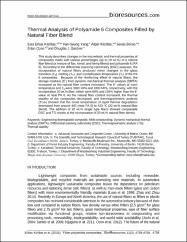Thermal Analysis of Polyamide 6 Composites Filled by Natural Fiber Blend

Göster/
Tarih
2016Yazar
Kızıltaş, Esra ErbaşYang, Han-Seung
Kızıltaş, Alper
Boran, Sevda
Özen, Ertan
Gardner, Douglas J.
Üst veri
Tüm öğe kaydını gösterÖzet
This study describes changes in the viscoelastic and thermal properties of composites made with various percentages (up to 20 wt.%) of a natural fiber blend (a mixture of flax, kenaf, and hemp fibers) and polyamide 6 (PA 6). According to the differential scanning calorimetry (DSC) analyses, the incorporation of natural fibers produced minor changes in the glass transition (T-g), melting (T-m), and crystallization temperature (T-c) of the PA 6 composites. Because of the reinforcing effect of natural fibers, the storage modulus (E') from dynamic mechanical thermal analysis (DMTA) increased as the natural fiber content increased. The E' values at room temperature and T-g were 3960 MPa and 1800 MPa, respectively, with the incorporation 20 wt.% fiber, which were 68% and 193% higher than the E' value of neat PA 6. As the natural fiber content increased, the thermal stability of the composites decreased, and thermogravimetric analysis (TGA) showed that the onset temperature of rapid thermal degradation decreased from around 440 (neat PA 6) to 420 degrees C (20 wt.% natural fiber blend). The addition of 20 wt.% single type fibers showed comparable DSC and TG results to the incorporation of 20 wt.% natural fiber blends.

















